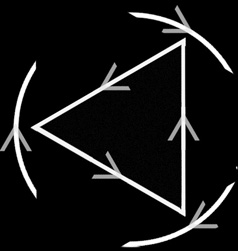

CONTACT trianglebounce@sonispheric.net

The closing movement adresses not only what was opened in the first, but what's gone on in between. Like pyramid and folded vortex, there's a polyrhythmic interlocking of guitar lines (a lot like what happens in much African ensemble guitar music, but with a different sound); but in this movement, the interlock is the main thing.
There's a common repeating melodic pattern crossed from different metrical points of view that can be combined in a lot of different ways (this movement will be different every time) making for a lot of sparkling, spacially strobing, (for those of you into Webern & Schoenberg -- or Billie Holiday, Bubber Miley or Jimi Hendrix) klangfarbenmelodie (tone color melody - as when two different intruments sound the same pitch in sequence)
The initial motif from dervish also makes a barely disguised reappearance as a changing signal. You'll hear it.

This movement corresponds with pyramid, the second movement. A composite melody has been derived from the 3 simultaneous lines in the canon frieze of pyramid. Then that's doubled and tripled upon itself with a lot of cut up and paste backtracking and such. This also includes 3 improvised solo sections for the guitarists to expand upon what's suggested here.



After 2 movements involving intensely metrical rhythms, and directly following the busier of the 2, this third movement slows down the activity in a very diferent way than the first. Here the melody is slowed down and stretched out as in dervish; but the durations are very open ended, even slower and more spacious still.
There's no easy way to emulate the interpretive possibilities the guitarists can bring to this episode with MIDI, so here is just a small hint of what it might be like. Hopefully the live delivery of this will incorporate the kind of movement heard in some classical Japanese court music, say, as with a trio of shakuhachi, shamisen and koto, but here with the more complex sonic pallette that's available to electric guitartists.

This second movement takes the Row, Row, Row your Boat round (canon) effect literally around the listeners. But the difference between this and an ordinarily round is that the relations among the parts are polyrhythmic and thus together assemble a groove, which is, in this case, a fairly elliptical one.
There are 3 different tempo strata active here, stacked fractal-like in a 2:3, and then 2:3 off that first 3, making it globally a 4:6:9 tempo spread.
But, enough techie talk, what you'll hear are things speeding up and slowing down in interesting and surprising ways.
This is also where you'll hear the core theme stated straight up toward the end (2:52 - 3;47).
The section from 0:44 to 2:46 might be cast for a much longer period of time during live performance as a frieze, a kind of sonic emulation of a stationary object, such as a traditional sculpture.

This opening movement is the one that most explicitly focuses on spatial movement. To that end, the core melody unfolds very, very slowly here so as to make it a lot easier to recognize the spatial melodies being constructed among the 3 separate instruments.
This might ask you for just a little patience at first, but if you relax and listen, it really will come to you -- and this is exactly the way it's supposed to ease up on listeners.
This is a very tightly coodinated movement that passes the guitarists a real challenge (despite its apparent simplicity) without adding any improvisation to the design.
Take your time and enjoy!
It's really tricky to convey some sense of what music that hasn't been played yet would really sound like in performance. What I've done here is to prepare some MIDI images off of the notation program for the scored part of the sonic design. I call them MIDI Mockups, kind of like the models that architects put together in advance of actually constructing a building. It means you have to aurally squint a bit and stretch your imagination to get an idea of how this would really sound.
The actual live set up would incorporate 3 separate electric guitars, whose speakers would form a triangle that face inward toward the audience. What the MIDI can't convey are all the nuances that actual instruments -- not to mention the very distinct musical personalities of each player -- would bring to the sound, As for the improvisations, well, they just haven't happened yet..I call t
I've used stereo panning to give the best possible representation of the spatial movement in the music. One guitar is exactly centered. Each of the other 2 is panned as far to the extreme right or left channel as possible.
IT'S BEST TO USE HEADPHONES (or well separated stereo speakers) TO HEAR THE SPATIAL MOVEMENT IN THE MUSIC'S SONIC DESIGN.

SOUND SAMPLES